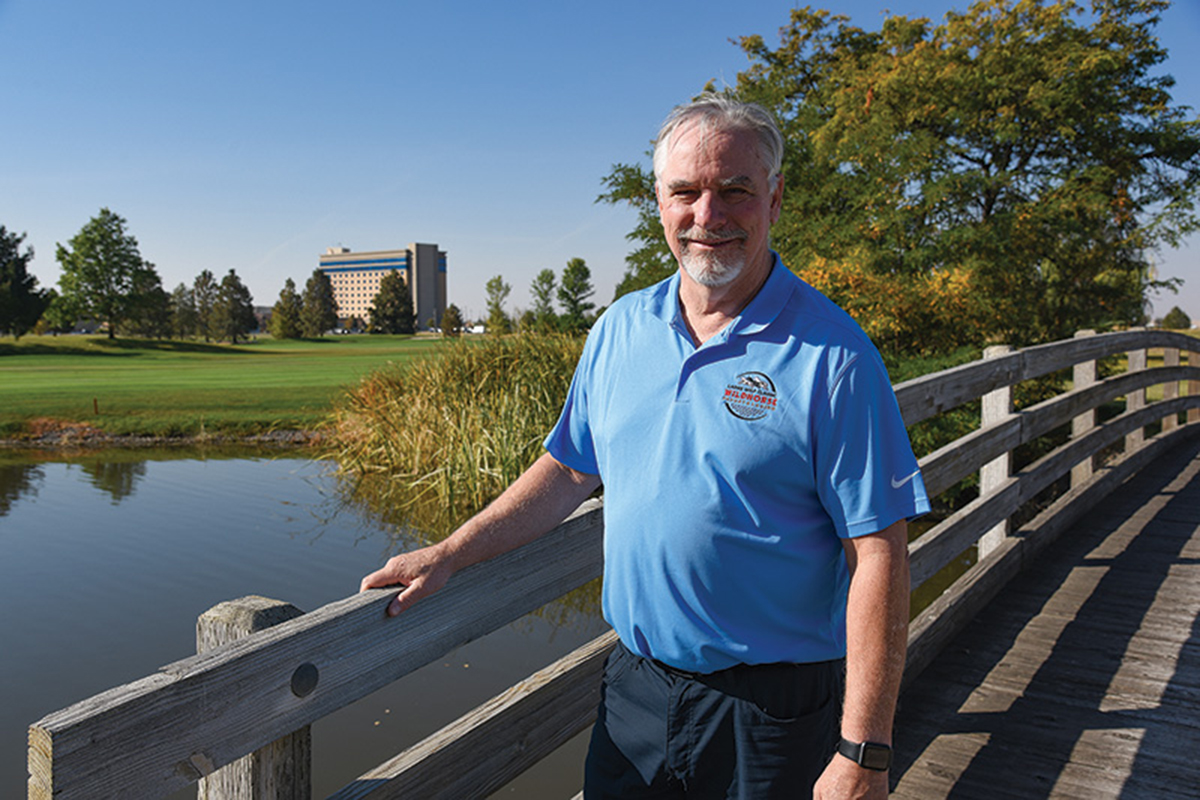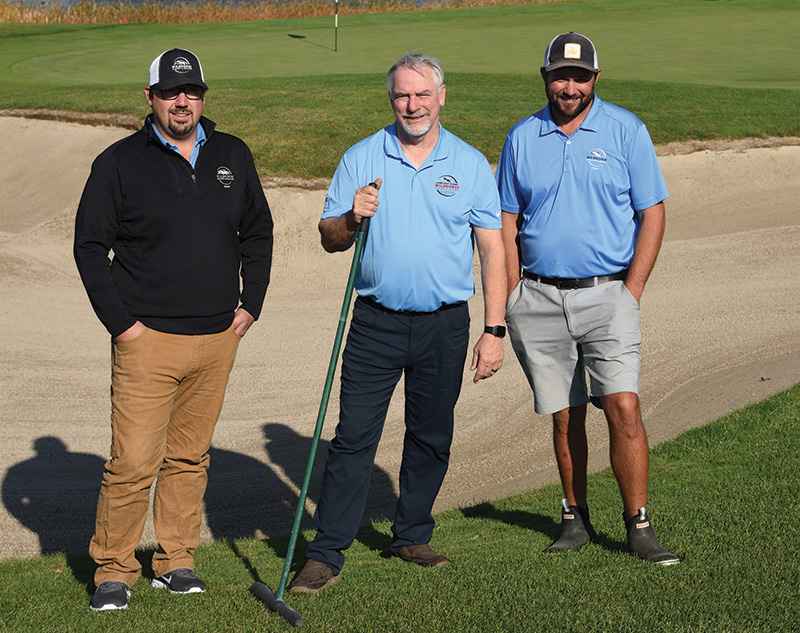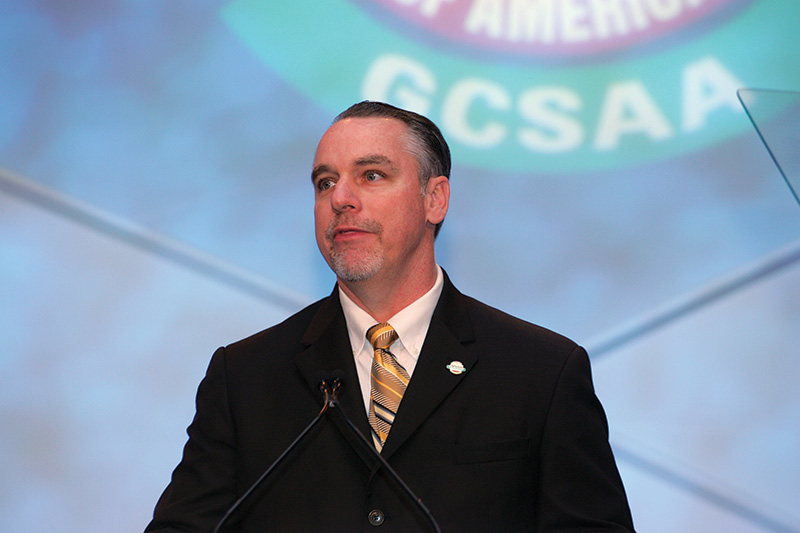Homecoming King: Hoolehan returns to Wildhorse Resort & Casino
by Lawrence Aylward

On some mornings last summer, Sean Hoolehan would glance around the golf course in sheer amazement and ask himself, “How did I get here?”
And then he would break into a big smile, ecstatic to be there – to be back.
Last June, Hoolehan returned to Wildhorse Resort & Casino in Pendleton, Ore., as its director of grounds after spending nearly five years working at The Retreat, Links & Spa at Silvies Valley Ranch in Seneca, Ore. Previously, Hoolehan spent more than 22 years of his 41-year career at Wildhorse as its golf course superintendent and helped build the resort’s original 18-hole Wildhorse Golf Course in 1996. If there’s a “home” course for Hoolehan, Wildhorse is it.
While Hoolehan doesn’t plan on retiring soon, he plans to retire from Wildhorse. It’s his last hurrah, and Hoolehan is thankful for the opportunity to be back. It’s not lost upon him that not everyone gets to return to a job they once revered to finish their careers.
“It feels great to be back,” says Hoolehan, a Certified Golf Course Superintendent and 39-year GCSAA member who served as the association’s president in 2006. “I pinch myself on some days that I’m here. But I’m not done. I’ve still got a way to go.”
This time around, Hoolehan will also oversee a second 18 holes owned and operated by the Confederated Tribes of the Umatilla Indian Reservation — the Golf Course at Birch Creek, formerly Pendleton Country Club, which the resort purchased in 2019.
An opportunity to return
Hoolehan left Wildhorse in 2017 to become superintendent at Silvies Valley Ranch, where he was promoted to chief operating officer and general manager in January 2021. Hoolehan didn’t leave Silvies because he didn’t like it. He enjoyed his stint there.
“That’s a great golf resort,” Hoolehan says of the Dan Hixson design, which features an 18-hole reversible course, played as the Craddock (on even days) and Hankins (on odd days) courses, one of only two in the U.S. It’s also located in the middle of an active ranch with real cowboys. “I’ll always sing the praises of Silvies,” he adds.
The only thing Hoolehan didn’t like about Silvies was its location. Seneca, which sits at the base of the Blue Mountain Range in eastern Oregon, has a population of about 250.
Hoolehan didn’t leave Wildhorse to go to Silvies because he felt like he needed to make a change. Silvies made him a generous offer, and Hoolehan was excited for the challenge and the chance to learn new things, most notably maintaining fine fescue turf. He figured, why not? His four children were grown and out of the house. So, he accepted the position, and he and his wife, Kathryn, moved to Seneca, which is about three hours south of Pendleton.
Gary George, CEO of Wildhorse, was sad to see Hoolehan go, but he was also happy for him. “We always hope that people go on to good things after they leave Wildhorse,” George says.
George and Hoolehan kept in touch during Hoolehan’s time at Silvies, and Hoolehan sometimes would stop by Wildhorse when he and Kathryn visited Pendleton to see friends.

Opportunity knocks
The path for Hoolehan’s return to Wildhorse began when Phil Lagao, CGCS, a 28-year GCSAA member who replaced Hoolehan when he left for Silvies, announced he was moving on to become the superintendent at Oregon’s Eugene Country Club. Hoolehan’s potential return was quickly set into motion when George contacted him about the opening a short time after Lagao’s announcement. George had a hunch Hoolehan might want to return to Pendleton, and he knew Wildhorse provided him an excellent opportunity to do so.
He was right. Hoolehan, feeling good about the time he spent at Silvies but yearning to get back to Pendleton, was thankful and excited for the opportunity to return to the course he grew-in and a job that he cherished. He half jokes that “it’s nice to get back to civilization” after spending nearly five years in a distant setting, but it’s more than that for him.
“It was the opportunity to come back and work with people who I consider my friends, many who I worked with for more than 20 years,” he says. “There wasn’t another job I would’ve been interested in. Wildhorse had treated me so well over the years and was so supportive of me when I was on the GCSAA board and its president.”
The job wasn’t handed to Hoolehan, though. According to Wildhorse’s rules, Hoolehan had to apply like others and interview. The hiring process took about six weeks. There were solid candidates, but nobody had a résumé quite like Hoolehan for this job.
“He was involved from day one when we started construction on the Wildhorse Golf Course,” George says. “He knows where every irrigation pipe is and where all the controllers and sprinkler heads are located.”
His hiring was a “no-brainer,” George adds. “It’s great to have him back. He is a big part of what we’ve built here.”
George was also always impressed with Hoolehan’s desire and ability to understand the Native American culture. Hoolehan spent more than seven years working as project manager for Ko’olau Golf Club in Kaneohe, Hawaii, and George believes that working in the Hawaiian culture helped him in understanding the Native American culture.
“He has developed some great relationships with our tribal communities,” George says. “He has helped grow the game of golf for our Native American community and for women and minorities.”
David Phipps, GCSAA’s field staff representative for the Northwest region, has known Hoolehan for many years. He says he was somewhat surprised when Hoolehan left Wildhorse for Silvies, but he was happy to hear of his return because Hoolehan was so well liked at Wildhorse.
“It was a great experience for him at Silvies, and he really set the place up to succeed,” Phipps says. “It was just time for Sean to move on and finish his career back at Wildhorse. He deserves it. He gives the best wherever he goes.”

An easy transition
It was an emotional first week for Hoolehan upon his return. There were many familiar faces and lots of hugs and handshakes. “I was overwhelmed by the number of people who were sincerely excited to have me back on the team,” Hoolehan says.
He laughs when he says he left a job title as chief operating officer and general manager to become a director of grounds, but Hoolehan knows it’s not a step down. “It’s an affirmation that Wildhorse is a really good place to work,” he says.
While he enjoyed the elevated titles and roles that he played during his last two years at Silvies Ranch, Hoolehan admits that he missed being the superintendent. That’s where his heart is. “I like to get at the golf course at 5:30 in the morning with a crew in front of me,” he says.
While some people who worked on his previous crews have moved on to bigger and better roles in the industry, Hoolehan says several crew members on the maintenance team remain, including several who worked for him for nearly his entire previous stint.
“A lot of people feel like he never left,” George says. “It has been an easy transition for him.”
After having been away for four and a half years, Hoolehan feels like he has a fresh set of eyes on the golf course. “It’s amazing how my perspective has changed,” he says. “I can see some things that I never saw. It’s clear to me about how to approach some things differently.”
Hoolehan says Wildhorse was definitely in good hands with Lagao during his time in charge, leaving the property in better shape than he found it. But that doesn’t mean there aren’t a few tasks Hoolehan’s itching to jump into, most notably some trees — ones that Hoolehan recalls planting — that need to come down because they are causing problems for the turf, the golfers and the infrastructure.
“There are some things I should have fixed before I left,” he says. “They’re going to get fixed now.”
Reestablishing connections
As much as he feels connected to the course, Hoolehan has never considered it “his baby.” He says the course belongs to the Confederated Tribes of the Umatilla Indian Reservation, whom Hoolehan greatly respects. He says he admires the reverence that Native Americans have for the land and nature in general.
“It’s my honor to maintain this course,” he says.
Hoolehan has also embraced the challenge of overseeing the second 18 holes, the Golf Course at Birch Creek, which is located about 8 miles from Wildhorse Golf Course. “That made the job more exciting and more of a challenge,” he says.
While Hoolehan oversees both courses, he has empowered Tyler Gabriel, an eight-year GCSAA member, to be the superintendent over Birch Creek. “He speaks my language, and I speak his, and we both appreciate that a lot,” Hoolehan says.
While he finds it “amazing” to sit in his office in a building he oversaw being built 25 years ago, Hoolehan won’t be caught kicking up his feet and putting them on his desk to relax. He has also returned to keep learning and says he’s already gaining “new tricks” from the younger people, like Gabriel, who are on his staff.
“You can never stop learning in this business, or you’re going to run into trouble,” Hoolehan says.
While there are many words Hoolehan uses to describe his emotions of returning to Wildhorse, there is a simple one that stands out from the others: happy.
Interestingly, many employees at Wildhorse are fond of giving each other nicknames. Before he left, Hoolehan was known as “The Leprechaun.” But that has changed now that he has returned.
During his first week, Hoolehan was often asked how it felt to be back. His one-word response (with a big grin) was “happy.”
Hence, his new Wildhorse nickname: “Happy Hoolehan.”
It’s a perfect fit for someone who has returned to a job he loves, and he has been welcomed with open arms.
Lawrence Aylward is a freelance writer from Medina, Ohio, who has covered the golf course maintenance industry for more than 20 years.
(This article first appeared on the GCSAA website, GCM Online, and is used here by permission.)






